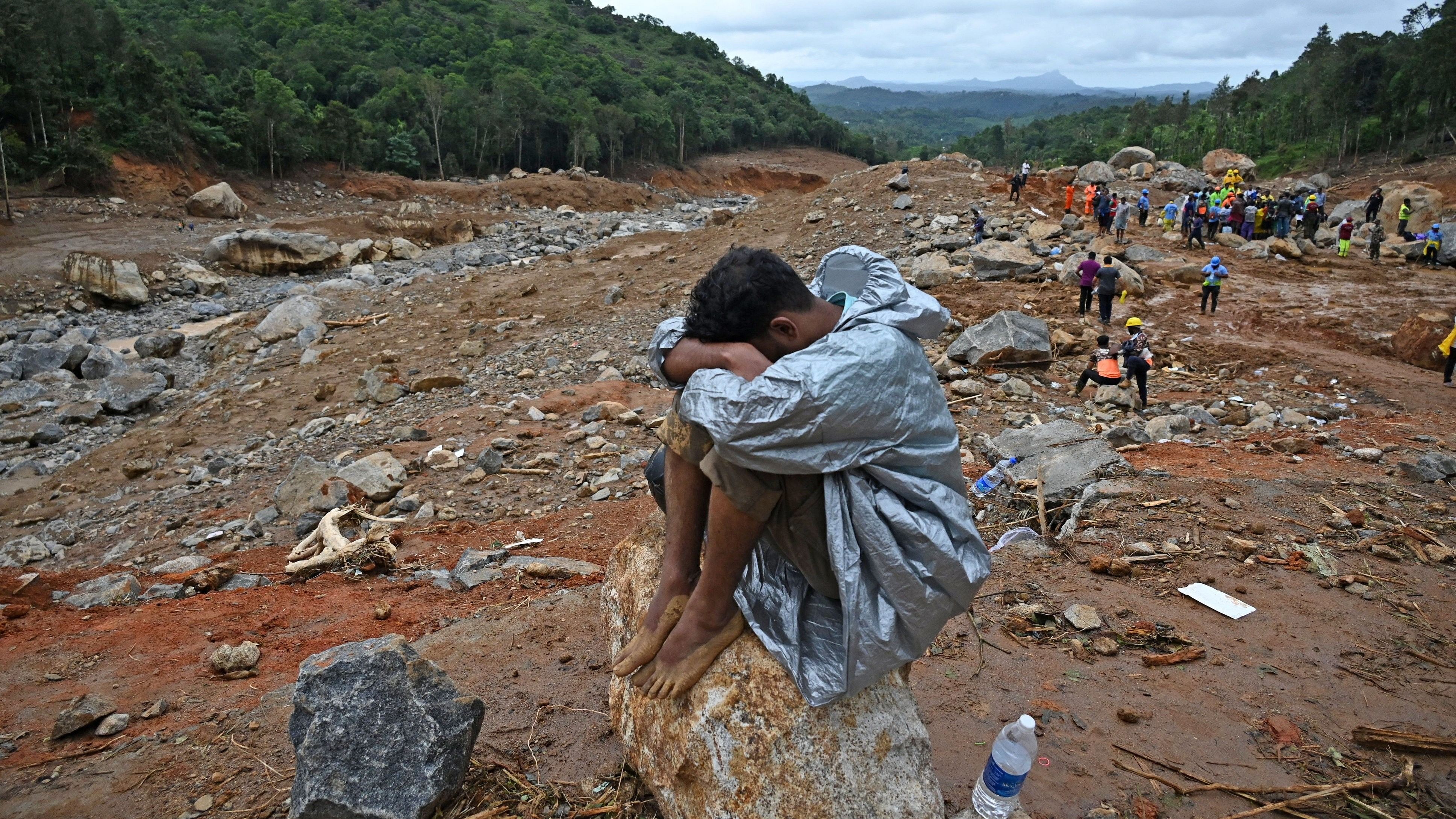
A resident of Mundakkai sits on a bolder amid the landslide hit area, where he lost family members, in Wayanad.
Credit: DH Photo/Pushkar V
As natural disasters become more frequent and severe, India’s disaster response funding system has critical slip-ups, leaving some states vulnerable. The current criteria for determining state government shares in the State Disaster Response Fund (SDRF) — population, geographical area, and Below Poverty Line (BPL) population — unfairly penalise states that excel in demographic management and poverty reduction. These criteria seem irrelevant for disaster response allocation and fail to capture natural disaster vulnerability accurately.
The Fifteenth Finance Commission (FC) introduced a new methodology for determining state shares in the SDRF, incorporating population, area, average past expenditure, and the Disaster Risk Index (DRI), which includes hazard probabilities and poverty-based vulnerability. However, the SDRF fund allocation parameters have resulted in significant fiscal discrimination against certain states.
As the Sixteenth FC finalises its report, it is crucial to address these methodological issues. Traditionally, the SDRF allocations, which are FC grants, were based on states’ past expenditures for disaster relief. With the revised methodology in place, there was a significant disparity between fund allocation and the actual vulnerability faced by the states.
Flawed criteria
The Fifteenth FC allocated Rs 1,28,122 crore for the SDRF. General category states receive 75% of the funds from the Union government, while special category states receive 90%. Maharashtra, Uttar Pradesh, Madhya Pradesh, Odisha, and Rajasthan are the top recipients, whereas northeastern states, Kerala, Himachal Pradesh, Chhattisgarh, and Telangana receive the least.
Using the 2011 census population as a key factor penalises South Indian states that have successfully implemented population control. While population size is a need-based criterion, the SDRF fund allocation should focus on risk and vulnerability rather than sheer population size.
Geographical area as a criterion for the SDRF fund allocation is another inaccurate criterion. Natural disasters impact specific regions, such as hilly areas, wetlands, and coastlines, more than others. Simply using a state’s geographical size does not address the unique risks posed by cyclones, earthquakes, floods, and landslides.
Geographically larger states may receive more funds even if they face less risk, leading to unfair distribution. The current SDRF framework, which allocates 15% weight each to area and population, does not accurately reflect the needs of states with higher disaster risk. Allocation criteria should prioritise disaster risk and vulnerability over, population and area alone.
To better address disaster risk, incorporating population density as a criterion would be more effective. Densely populated areas face higher risks, casualties, and losses during natural disasters. Adjusting the allocation to reflect this would ensure a more equitable distribution of funds, aligning resources with actual needs and vulnerabilities.
The SDRF fund allocation heavily relies on the past seven years’ average expenditure on relief measures, accounting for 70% of the criteria. This focus on historical expenditure means states with higher past expenses receive more funds, regardless of their current risk and vulnerability to natural disasters.
Concerns with disaster risk index calculation
Currently, the Disaster Risk Index (DRI) is derived from hazard and vulnerability scores. The hazard score, out of 70, is based on the probability of frequent natural disasters in India, with states classified as high, medium, or low risk. The vulnerability score, out of 30, is based on the BPL, which is a rudimentary measure of vulnerability.
Using the BPL as a measure of vulnerability is problematic. Vulnerability should consider exposure to hazards and the population’s capacity to adapt and be resilient. This method unfairly penalises states that have successfully reduced poverty, like those in South India, leading to a mismatch between hazard scores and vulnerability measures. States such as Odisha, Gujarat, West Bengal, Andhra Pradesh, Bihar, Maharashtra, Uttar Pradesh, Kerala, Tamil Nadu, and Arunachal Pradesh have high hazard scores. However, using BPL populations as the primary vulnerability measure lowers the overall scores of Andhra Pradesh, Kerala, and Tamil Nadu. Consequently, these states rank low in the overall DRI and receive less SDRF funding, despite being high or medium hazard states.
Replacing the BPL population criteria with a composite vulnerability score from the National Disaster Management Authority (NDMA) would provide a more accurate picture. If this were done, Gujarat, Andhra Pradesh, West Bengal, Bihar, Maharashtra, Odisha, Tamil Nadu, Uttar Pradesh, Karnataka, and Kerala would be recognised as having high DRI scores and would justifiably receive more funds. However, the current framework’s inclusion of population, geographical area, and BPL population results in those states receiving a higher share of the SDRF funds which may not be necessarily high risk category in terms of hazards and exposure to natural disasters.
Revisit SDRF criteria
To make the SDRF more equitable, the 16th FC should revise the criteria. Replace population and area with population density to better capture disaster risk. Include geographical subdivisions prone to natural disasters for ecological fiscal transfers. Use a composite vulnerability index instead of the BPL for the DRI. Measure risk as the probability of disasters multiplied by the degree of vulnerability.
The current approach, which separates these factors, is flawed and could lead to disproportionate funding, insufficient for effective disaster response.
(Aswathy Rachel Varughese is assistant professor, and Rju Mohan is PhD scholar, Gulati Institute of Finance and Taxation, Thiruvananthapuram.)
Disclaimer: The views expressed above are the author's own. They do not necessarily reflect the views of DH.